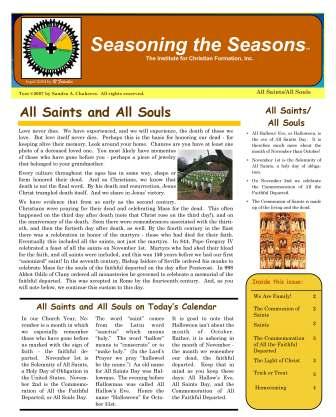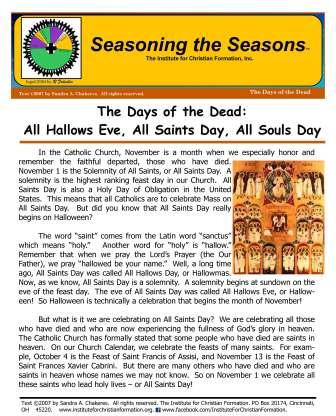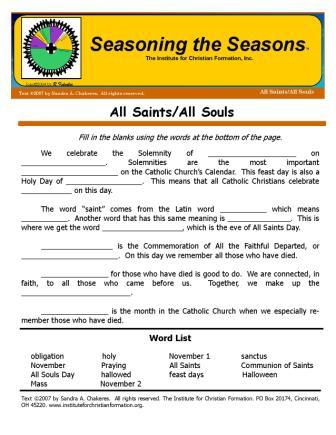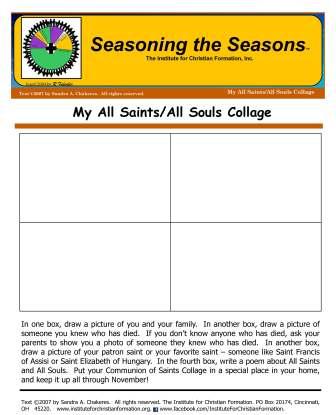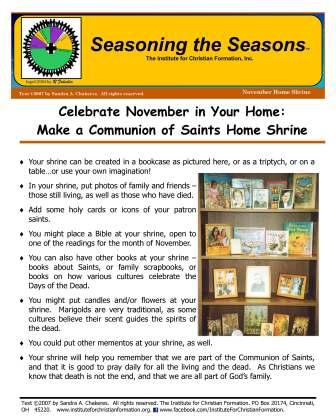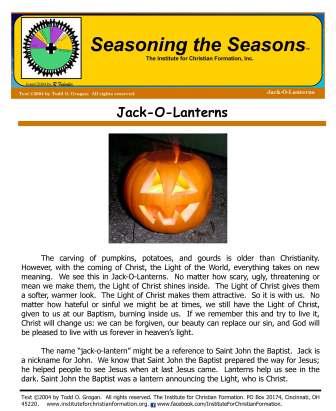The Institute for Christian Formation
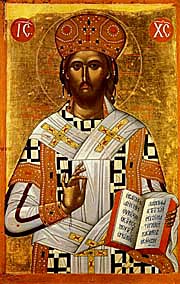
The Solemnity of All Saints: November 1
The Commemoration of All the Faithful Departed:
Follow us on Facebook to keep up to date with our news and newest resources!
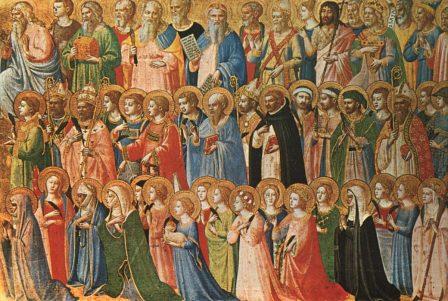
Christ Glorified in the Court of Heaven
Fra Angelico, 1428-1430
National Gallery, London, UK
In our Church Year, November is a month in which we especially remember those who have gone before us marked with the sign of faith - the faithful departed. November 1st is the Solemnity of All Saints, a Holy Day of Obligation in the United States. November 2nd is the Commemoration of All the Faithful Departed, or All Souls Day.
The word “saint” comes from the Latin word “sanctus” which means “holy.” The word “hallow” means to “consecrate” or to “make holy.” (In
the Lord’s Prayer we pray “hallowed be thy name.”) An old name for All Saints Day was Hallowmas. The evening before Hallowmas was called All Hallow’s Eve. Hence the name “Halloween” for October 31st.
It is good to note that Halloween isn’t about the month of October. Rather, it is ushering in the month of November - the month we remember our dead, the faithful departed. Keep that in mind as you keep these days: All Hallow’s Eve, All Saints Day, and the Commemoration of All the Faithful Departed.
Learn much more by downloading our ICF All Saints/All Souls handouts and bulletins below.
Click on the image above to download our 4-page ICF All Saints/All Souls Bulletin.
Click on the image above to download our 3-page ICF Days of the Dead Handout.
Click on the image above to download our ICF All Saints/All Souls Fill-in-the-Blank Activity.
Click on the image above to download our ICF All Saints/All Souls Collage Activity.
Click on the image above to download our ICF November Home Shrine directions.
Click on the image above to download our ICF Jack-O-Lantern handout.
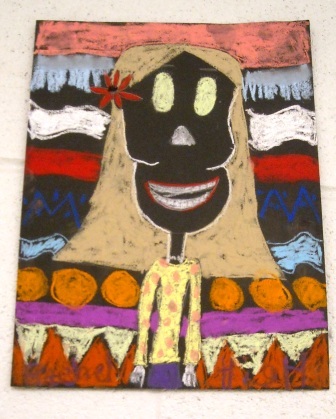
Day of the Dead Art
by school children at Annunciation Parish School, Cincinnati, Ohio.
Photo by Sandra Chakeres.
Days of the Dead
From very ancient times, those who are living have remembered and honored their dead. How this has been done has varied somewhat from culture to culture. Many of our modern traditions and customs come from these ancient practices. In Mexico and Central America and other Hispanic cultures, November 2nd is celebrated as Día de los Muertos, or the Day of the Dead. In homes, an altar or ofrenda, is set up, which might include such items as photos of the deceased, decorated sugar skulls, wildly dressed skeletons, candles, and foods and beverages favored by the deceased. Rather than being a time of mourning, this takes on a much more
celebratory nature, much like a family reunion.
Sometimes this celebration is spread out over three days, October 31-November 2nd, the Days of the Dead. Celebrations such as the Day of the Dead help us to remember that we really are all one family. Even death cannot separate us from the love of God and the love of one another!
In the video below by the Peabody Museum, David Carrasco of Harvard Divinity School explains symbolism of the Day of the Dead Altars.
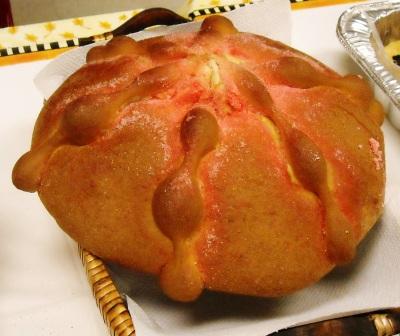
Pan de Muertos
(Mexican Bread of the Dead)
Photo by Sandra Chakeres
There are some excellent educator resource packets available for the Days of the Dead. Here is one from azcentral.com Here is another good educator resource packet from mexic-artemuseum.org. And don’t forget to make Pan de Muertos (Mexican Bread of the Dead) for your celebration! Here is one recipe.
Trick-or-Treat
In Celtic Britain, Samhain was celebrated on October 31st. The people believed that at Samhain, the spirits of the dead roamed around creating fear and havoc. So, to chase these spirits away, the people sometimes dressed up like them. And this was an ancient version of our modern-day Halloween costume. People would mock death by dressing up like skeletons or ghosts or ghouls.
Now, of course, if the spirits roaming around happened to be your deceased relatives and friends, you might invite these spirits into your home to get warm by the fire and share some food. By the Middle Ages, Christians began “souling.” They would go to homes begging for a “soul cake” in exchange for saying a prayer for the dead:
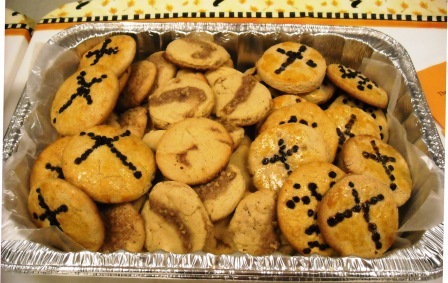
"Soul Cakes"
Photo by Sandra Chakeres
A soul cake, a soul cake,
Pray, good missus, a soul cake…
One for Peter, two for Paul,
Three for Him who made us all…
So our modern version of Trick or Treat, just like Halloween costumes, themselves, has very ancient roots. Perhaps it is true that there is nothing new under the sun!
Here is a traditional recipe for Soul Cakes.
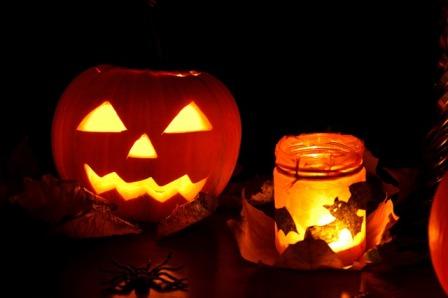
Is there a connection between John the Baptist and Jack-O-Lanterns? Find out by downloading our ICF Jack-O-Lantern handout above on this page!
Praying for the Faithful Departed
Remember to pray for those who have died and gone before us! We do this all through the year, but remember our dead in a special way during the month of November. This is also an excellent time to visit a cemetery. And don't forget to sing your prayer, as well. "For All the Saints" is an excellent hymn, and you can download the score here.
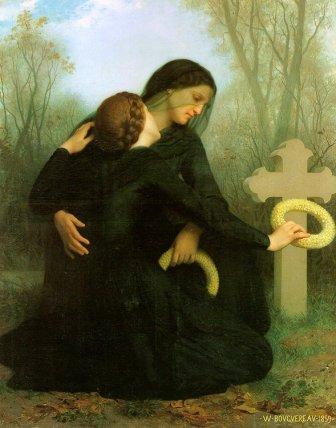
All Saints Day
William-Adolphe Bouguereau, 1859
Prayer for the Faithful Departed
Eternal rest grant unto them,
O Lord,
and let perpetual light
shine upon them.
May the souls of all the
faithful departed,
through the mercy of God,
rest in peace.
Amen.
